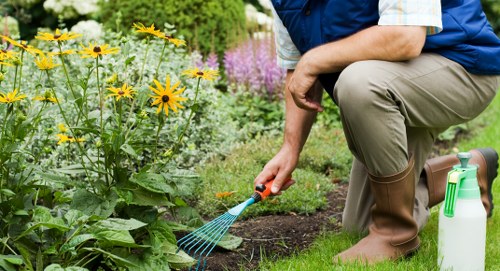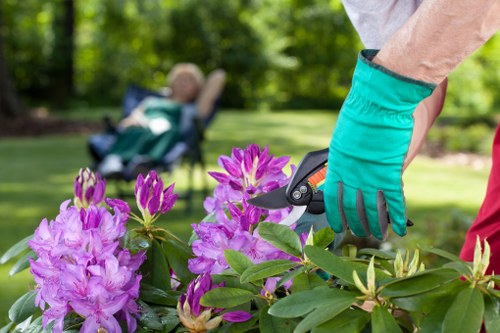The Ultimate Guide to Hedge Trimming: Techniques, Tips, and Best Practices
Introduction to Hedge Trimming

Hedge trimming is an essential aspect of garden maintenance, ensuring that hedges and shrubs remain healthy, attractive, and well-shaped. Regular trimming not only enhances the aesthetic appeal of your landscape but also promotes the growth and longevity of the plants.
Understanding the fundamentals of hedge trimming can help both novice and experienced gardeners achieve professional-looking results. This article delves into various techniques, tools, and best practices to help you master the art of hedge trimming.
Whether you're maintaining a formal garden, a naturalistic landscape, or simply keeping your fence hedges in check, proper trimming techniques can make a significant difference in the overall appearance and health of your plants.
Why Hedge Trimming is Important

Regular hedge trimming serves multiple purposes. Firstly, it helps maintain the shape and size of the hedge, preventing it from becoming overgrown and unruly. Secondly, trimming removes dead or diseased branches, which can improve the overall health of the plant.
Additionally, hedge trimming allows more light and air to penetrate the foliage, reducing the risk of fungal diseases and promoting vigorous growth. A well-maintained hedge can also act as a barrier, providing privacy and reducing noise from the surrounding environment.
Moreover, properly trimmed hedges can enhance the curb appeal of your home, adding structure and beauty to your outdoor space. Whether used as a backdrop for flower beds or as a standalone feature, hedges play a crucial role in landscape design.
Essential Tools for Hedge Trimming

Having the right tools is paramount to achieving precise and efficient hedge trimming. The most commonly used tools include hedge shears, electric trimmers, and manual clippers.
Hedge Shears: Ideal for shaping hedges and cutting through dense foliage, hedge shears come in various sizes and styles to suit different types of plants. They provide a clean cut, which is essential for the plant’s health.
Electric Trimmers: Perfect for larger hedges, electric trimmers offer power and speed. They are especially useful for tackling thick or tall hedges without excessive physical exertion.
- Manual Clippers for Precision Work
- Pruning Saws for Thick Branches
- Protective Gear to Ensure Safety
Best Practices for Effective Hedge Trimming

Adhering to best practices ensures that your hedge trimming efforts yield the best possible results. Here are some key practices to follow:
Timing: The best time to trim hedges is during the late spring or early summer when the plants are actively growing. Avoid trimming during extreme weather conditions or when the plant is dormant.
Technique: Trim hedges in a systematic manner, working from the bottom up to ensure an even shape. Use smooth, deliberate cuts to prevent jagged edges that can be detrimental to plant health.
- Regular Maintenance Trims
- Shaping and Forming the Hedges
- Removing Dead or Damaged Branches
Common Mistakes to Avoid

Even with the right tools and knowledge, beginners often make mistakes that can harm their hedges. Here are some common errors to watch out for:
Over-Trimming: Cutting too much foliage can stress the plant, making it vulnerable to diseases and pests. Always trim conservatively and gradually shape the hedge over multiple sessions if necessary.
Ignoring Plant Health: Failing to remove sick or dead branches can lead to the spread of diseases. Regularly inspect your hedges and promptly address any signs of trouble.
Improper Timing: Trimming at the wrong time of year can disrupt the plant’s growth cycle. Always research the specific needs of your hedge species before trimming.
Advanced Trimming Techniques

For those looking to take their hedge trimming skills to the next level, several advanced techniques can enhance both the appearance and health of your hedges.
Topiary: This artistic form of trimming involves shaping hedges into intricate designs and figures. It requires precision and creativity, making it a rewarding challenge for skilled gardeners.
Feathering: Feathering creates a natural, layered look by trimming the upper parts of the hedge more than the lower parts. This technique allows more light and air to reach the base of the plant.
- Creating Unique Shapes and Designs
- Enhancing Light Penetration
- Promoting Even Growth
Choosing the Right Hedge for Your Garden

Selecting the appropriate hedge species is crucial for easy maintenance and optimal appearance. Consider factors such as growth rate, foliage type, and climate suitability when choosing your hedge.
Popular hedge varieties include:
- Boxwood: Known for its dense, evergreen foliage, boxwood is perfect for formal gardens and intricate topiary.
- Privet: Fast-growing and hardy, privet is ideal for creating tall, privacy screens.
- Laurel: With large, glossy leaves, laurel hedges provide year-round coverage and a lush appearance.
Each species has its own trimming requirements, so familiarize yourself with their specific needs to ensure successful maintenance.
Maintaining Hedge Trimmers

Proper maintenance of your hedge trimming tools is essential for achieving clean cuts and prolonging the life of the tools. Follow these tips to keep your hedge trimmers in optimal condition:
Cleaning: After each use, clean your trimmers to remove sap, dirt, and debris. This prevents rust and ensures smooth operation.
Sharpening Blades: Regularly sharpen the blades to maintain their cutting efficiency. Dull blades can damage the plant and require more effort to trim.
- Lubricate Moving Parts
- Store Tools in a Dry Place
- Check for Wear and Tear
Environmental Benefits of Hedge Trimming

Beyond aesthetic appeal, hedge trimming offers several environmental benefits. Well-maintained hedges contribute to a healthier ecosystem in your garden.
Improved Air Quality: Healthy hedges absorb carbon dioxide and release oxygen, enhancing the air quality around your home.
Wildlife Habitat: Trimming hedges encourages new growth, providing habitats and food sources for birds, insects, and other wildlife.
- Promoting Biodiversity
- Reducing Soil Erosion
- Enhancing Microclimates
Safety Tips for Hedge Trimming

Maintaining safety during hedge trimming is paramount to prevent accidents and injuries. Follow these essential safety tips:
Wear Protective Gear: Always wear gloves, safety goggles, and sturdy footwear to protect yourself from debris and sharp tools.
Stable Positioning: Ensure your ladder is on a stable surface if working on elevated hedges. Never overreach, and ask for assistance if needed.
- Inspect Tools Before Use
- Avoid Trimming in Poor Weather Conditions
- Be Aware of Your Surroundings
Seasonal Hedge Trimming Tips
[IMG_11]Different seasons require different trimming approaches to ensure the health and growth of your hedges throughout the year.
Spring: Focus on shaping and removing any winter damage. This is also a good time to fertilize your hedges to support new growth.
Summer: Conduct light trims to maintain shape and encourage dense foliage. Ensure adequate watering during dry spells.
- Prune Flowering Hedges After Blooming
- Control Growth to Prevent Overcrowding
- Protect Hedges from Pests and Diseases
Choosing Between Manual and Power Trimmers
[IMG_12]Deciding between manual and power trimmers depends on the size of your hedges and your personal preference. Both options have their advantages and limitations.
Manual Trimmers: Best for small to medium-sized hedges, manual trimmers offer precision and control. They are also quieter and more environmentally friendly compared to power trimmers.
Power Trimmers: Suitable for large or dense hedges, power trimmers save time and reduce physical effort. They are ideal for extensive trimming tasks but require regular maintenance and safety precautions.
- Evaluate Hedge Size and Density
- Consider Physical Effort and Time
- Assess Noise and Environmental Impact
Eco-Friendly Hedge Trimming Practices
[IMG_13]Adopting eco-friendly practices in hedge trimming not only benefits your garden but also the environment.
Composting Clippings: Instead of disposing of hedge trimmings in the trash, compost them to create nutrient-rich soil for your garden.
Using Sustainable Tools: Choose tools made from sustainable materials and opt for electric or battery-powered trimmers to reduce carbon emissions.
- Implement Water Conservation Techniques
- Encourage Beneficial Insects through Habitat Creation
- Use Organic Fertilizers and Pest Control Methods
Hiring Professional Hedge Trimming Services
[IMG_14]While many homeowners handle hedge trimming themselves, hiring professional services can offer several benefits. Professionals bring expertise, experience, and the right tools to ensure high-quality results.
Expertise: Professional trimmers understand the specific needs of different hedge species and can tailor their approach accordingly.
Time Efficiency: Outsourcing hedge trimming frees up your time, allowing you to focus on other aspects of garden maintenance or personal activities.
- Assessing Service Quality and Reliability
- Understanding Pricing Structures
- Ensuring Safety and Compliance
Conclusion: Achieving Perfect Hedges
[IMG_15]Mastering hedge trimming requires a combination of knowledge, skill, and the right tools. By following the techniques and best practices outlined in this guide, you can maintain healthy, beautiful hedges that enhance the beauty and functionality of your garden.
Remember to prioritize plant health, safety, and environmental considerations in your trimming routine. Whether you choose to trim your hedges yourself or hire professionals, consistent maintenance is key to achieving and preserving perfect hedges.
Ready to transform your garden with expertly trimmed hedges? Contact us today to schedule your hedge trimming service and give your garden the care it deserves.